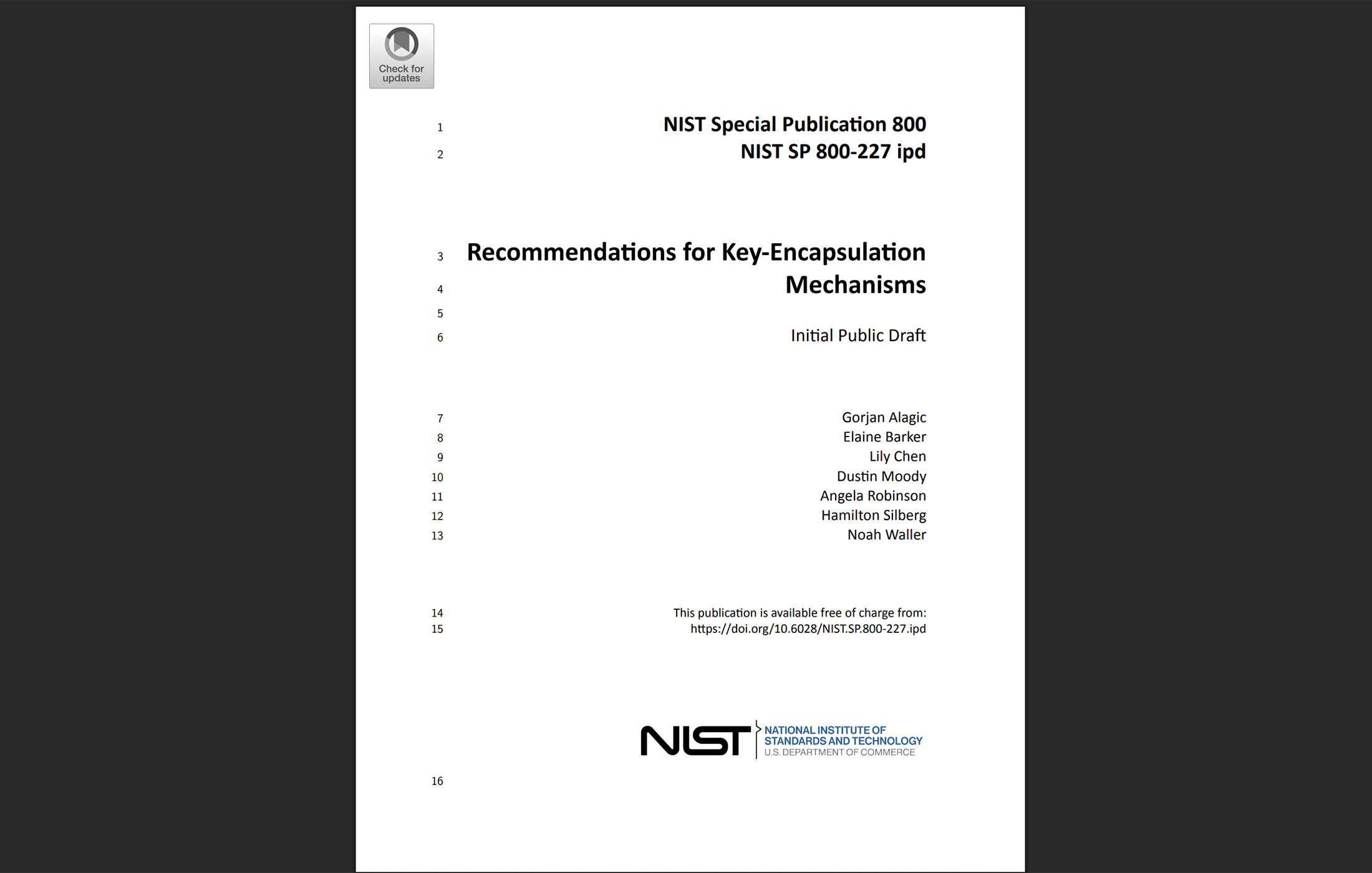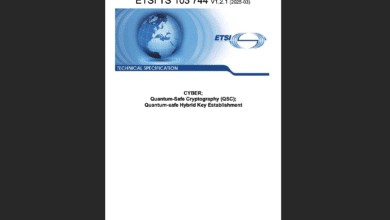NIST Releases NIST SP 800-227 IPD

Jan 2025 – NIST has just released the initial public draft of SP 800-227 “Recommendations for Key-Encapsulation Mechanisms” [PDF]. This draft is a significant milestone in the push for quantum-resistant cryptography, aimed at helping organizations prepare for a future with quantum computers.
The document arrives on the heels of NIST’s first post-quantum key-establishment standard (FIPS 203, which standardized a lattice-based KEM) and as NIST considers additional quantum-safe KEM algorithms for standardization. SP 800-227 (Draft) is NIST’s answer to an important question: now that new post-quantum KEMs are emerging, how should we implement and deploy them securely? According to NIST’s announcement, this draft “describes the basic definitions, properties, and applications of KEMs” and “provides recommendations for implementing and using KEMs in a secure manner”.
In short, it’s both a primer and a guidebook for anyone – especially CISOs and cybersecurity engineers – looking to safely integrate KEMs into their security infrastructure.
What is a KEM? A key-encapsulation mechanism is a public-key cryptographic primitive used to establish a shared secret key between parties over an open network. Unlike traditional Diffie-Hellman-style key agreement (where both parties contribute to the secret), a KEM typically works more like key transport: one party generates a random secret and “encapsulates” it (encrypts it) with the recipient’s public key, so that only the intended recipient can recover (decapsulate) the secret. The shared secret from a KEM can then be used as a symmetric key for encryption, authentication, or other cryptographic functions. KEMs are central to many post-quantum algorithms – for example, NIST’s PQC finalists for key exchange are KEMs – so having a clear understanding and guidance for KEMs is vital for quantum-readiness.
Inside NIST SP 800-227 (Draft): Definitions, Requirements, and Examples
SP 800-227 (Draft) starts from the ground up, establishing what a KEM is and how it should behave. The document provides formal definitions and requirements for KEM algorithms. For example, it defines the components of a KEM (key-generation, encapsulation, decapsulation, etc.) and the notion of correctness – i.e. if you encapsulate a key and then decapsulate it with the proper secret key, you should get the same shared secret back. A KEM that meets this correctness criterion can still be insecure, so the draft introduces cryptographic security definitions for KEMs in a rigorous but readable way.
One of the core security properties defined is IND-CPA (indistinguishability under chosen-plaintext attack), which essentially means the KEM’s ciphertexts are indistinguishable from random to any passive eavesdropper. In the draft, NIST explains IND-CPA in simple terms: an adversary that only observes the public encapsulation key and a ciphertext shouldn’t be able to guess the encapsulated key any better than random chance. This captures security against passive attackers. More importantly, the document highlights IND-CCA (indistinguishability under chosen-ciphertext attack) as the gold standard for KEM security, protecting against active attackers who can tamper with ciphertexts. In an IND-CCA experiment, the adversary is even given “oracle” access to a decapsulation function (simulating an attacker who tricks a legitimate party into decrypting bogus ciphertexts) and still shouldn’t learn the shared secret. SP 800-227 makes it clear that IND-CCA-secure KEMs are strongly preferred for real-world use whenever possible, since active man-in-the-middle or replay attackers are a practical concern. (It’s noted, for instance, that the first post-quantum KEM standardized by NIST – a module-lattice KEM – is believed to meet IND-CCA security.) Only in limited scenarios like purely ephemeral one-off key exchanges might an IND-CPA KEM be acceptable, and even then with caution. For practitioners, these definitions aren’t just theoretical – they translate to guidance on which algorithms to choose. If you’re selecting a KEM for your VPN or internal applications, NIST’s advice is to opt for an IND-CCA secure KEM to defend against active attacks.
Beyond definitions, SP 800-227 provides a set of requirements and best practices for implementing KEMs and using them within protocols. Many of these recommendations will sound familiar to seasoned security engineers, underlining their importance. For example, any random bits needed by a KEM (e.g. to generate key pairs or random encapsulated keys) must be generated using approved cryptographic random number generators, such as those specified in NIST SP 800-90 series. This ensures that the strength of the KEM isn’t undermined by a weak RNG. Another requirement is that all secret intermediate values should be erased from memory as soon as they are no longer needed, a defense against side-channel or memory disclosure attacks. The draft goes on to cover proper selection of security parameters (administrators should choose parameter sets that meet the desired security strength for their application, rather than, say, using a toy security level in production).
Crucially, the guidance extends to how KEMs are used in a larger protocol context. One highlight is Key Confirmation – the process of verifying that both parties indeed derived the same shared secret key, and that no active attacker has compromised the exchange. SP 800-227 explains that key confirmation isn’t automatically provided by all KEMs (since a KEM by itself may not alert either party if something went wrong), so in scenarios where it matters, an explicit key confirmation step should be added. The draft even specifies how to do this safely: for instance, if the decapsulating party sends a nonce or token to be MACed (message-authentication-coded) by the encapsulating party using the shared secret, the nonce should be of sufficient length (at least as many bits as the KEM’s security strength). The MAC algorithm used for key confirmation should be a strong, approved one (HMAC, KMAC, or CMAC) and the key for the MAC – derived from the KEM’s shared secret – must only be used for that confirmation purpose and then destroyed. All of these details ensure that the act of confirming the key doesn’t inadvertently leak information or create a new vulnerability. For practitioners, this is a welcome clarification: if you’re designing a protocol with a KEM (for example, a custom secure messaging scheme), SP 800-227 gives you a template for adding a robust key confirmation phase to thwart active attackers.
To make the abstract concepts more concrete, the draft includes example KEMs and use-cases. It walks through how some well-known schemes can be viewed in the KEM framework. For instance, it presents ECDH-KEM (an elliptic curve Diffie-Hellman based KEM) and RSASVE-KEM (an RSA-based KEM derived from RSA’s simple variant encryption) as examples of traditional algorithms repackaged as KEMs. It also showcases “ML-KEM,” a module-lattice post-quantum KEM (essentially the family of lattice-based KEMs like Kyber) as an example of a modern quantum-resistant scheme. By including both classical and post-quantum examples, the document helps readers see how the recommendations apply across different algorithms. The examples illustrate how to generate keys, encapsulate, and decapsulate in each case, and they reference existing NIST standards (for example, pointing out that ECDH-KEM’s steps align with the approved procedures in SP 800-56Ar3 for Diffie-Hellman). For a cybersecurity engineer, these examples provide a sanity check: if your implementation of a KEM follows similar steps and meets the listed requirements, you’re likely on the right track.
Why This Document Matters for Quantum-Readiness
NIST SP 800-227 is more than just a technical checklist – it’s a strategic document in the quantum-readiness agenda. As organizations prepare to transition their cryptography to quantum-safe alternatives, guidance on how to do that safely is as important as the new algorithms themselves. KEMs will play a central role in most post-quantum key exchange protocols (think of how TLS key agreements or VPN handshakes will evolve), and SP 800-227 is aimed at smoothing that transition for practitioners. NIST acknowledges that when they standardized their first PQC KEM, there was a lack of “extensive guidance on the basic definitions, properties, and applications of KEMs”. This document is explicitly meant to fill that gap. In other words, it supplements the algorithm standards by telling you how to use those algorithms correctly.
Another vital aspect for the quantum-readiness effort is interoperability and confidence. By standardizing terminology and expectations (what exactly does “secure KEM” mean? what checks should an implementation have?), NIST is helping ensure that different vendors and projects implement KEMs in compatible and secure ways. This reduces the risk that, say, one vendor’s “quantum-resistant” solution is using a weak configuration or leaving out a key confirmation step that another vendor includes. When everyone follows the same playbook, it’s easier to mix and match components (e.g., using one company’s PQ crypto library with another’s network appliance) without worrying about mismatched assumptions. In essence, SP 800-227 is about building a common language and baseline for KEM security. This will be increasingly important as we head toward large-scale deployment of PQC: organizations will want assurance that a PQC product not only uses strong algorithms, but uses them in the right way. NIST’s imprimatur on recommended practices can provide that assurance.
Key Highlights and Strengths of SP 800-227 (Draft)
With the above points in mind, it’s worth highlighting what SP 800-227 brings to the table and why it’s uniquely valuable:
- Clear Definitions and Security Models: The draft excels at explaining cryptographic concepts without dumbing them down. It introduces the formal security notions (like IND-CPA and IND-CCA) in an informal way that a practitioner can grasp, while still being rigorous. The fact that the document notes real-world experience – “adversaries can sometimes actively interfere with key-establishment processes” – shows that it’s grounded in practical security, not just theory.
- Modular and Comprehensive Guidance: Another strength of SP 800-227 is how it blends prescriptive requirements with explanatory context. The document explicitly delineates which statements are mandatory (“shall” or “must”) and which sections are purely educational.
- Attention to Deployment and Implementation Security: SP 800-227’s recommendations drill down into what it means to securely implement a KEM. We’ve already mentioned the requirements for using approved randomness and zeroizing secrets. It also brings in considerations like side-channel resistance and physical security of devices: a footnote in the guidance acknowledges that an implementation might be acceptable in one scenario (a locked-down data center) but not in another (an unprotected IoT device) if, for example, it lacks side-channel countermeasures. This level of detail shows a real awareness of how cryptography fails in practice. Following these recommendations will greatly reduce the chance of an implementation bug or oversight undermining an otherwise strong post-quantum scheme.
- Forward-Looking Support for Hybrid Schemes: Perhaps the most forward-looking (and practically significant in the near term) aspect of SP 800-227 is its guidance on hybrid key-establishment models. The document introduces the concept of a composite KEM, which is a mechanism to combine two (or more) KEM algorithms into one unified scheme. In a typical use-case, this might mean pairing a post-quantum KEM with a traditional ECC or RSA-based KEM so that the resulting shared secret is secure unless both algorithms are broken. The draft outlines how to do this composition properly: it suggests choosing parameter sets for each component algorithm and then using an approved key combiner function to merge the two keys into one shared secret. It even notes that the approach can be generalized (e.g., combining more than two schemes, or even combining a KEM with a non-KEM method). Why is this important? Because many organizations aren’t going to flip a switch and move to purely post-quantum crypto overnight – they will run hybrid solutions during a transition period (for example, TLS 1.3 could use both an ECDH exchange and a PQC KEM in tandem). By baking hybrid guidance into SP 800-227, NIST is giving a green light to this strategy, but also making sure it’s done in a secure and standardized way. Practitioners planning for quantum readiness should take note: the document essentially provides a recipe for how to be quantum-safe while still retaining classical security as a safety net. This kind of guidance is unique and was not present in older NIST key management guidelines. It’s a strong point of the draft, showing that NIST is anticipating real-world deployment needs in the coming decade.
In summary, SP 800-227 (Initial Public Draft) comes across as a well-thought-out blend of theory and practice. Its strengths lie in clarity, thoroughness, and relevance. It’s written in a tone that is technical and serious – as one would expect from NIST – but it remains approachable. The absence of marketing fluff (nowhere in the document will you find salesy language or exaggerated promises) and the presence of concrete examples and “shall” statements make it an engineer’s document at heart.
Quantum Upside & Quantum Risk - Handled
My company - Applied Quantum - helps governments, enterprises, and investors prepare for both the upside and the risk of quantum technologies. We deliver concise board and investor briefings; demystify quantum computing, sensing, and communications; craft national and corporate strategies to capture advantage; and turn plans into delivery. We help you mitigate the cquantum risk by executing crypto‑inventory, crypto‑agility implementation, PQC migration, and broader defenses against the quantum threat. We run vendor due diligence, proof‑of‑value pilots, standards and policy alignment, workforce training, and procurement support, then oversee implementation across your organization. Contact me if you want help.



